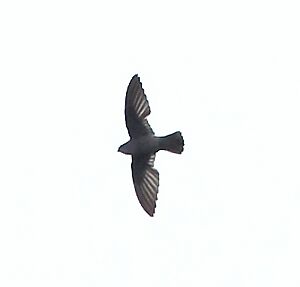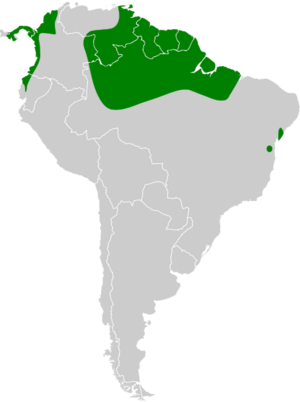Band-rumped swift facts for kids
Quick facts for kids Band-rumped swift |
|
|---|---|
 |
|
| Conservation status | |
| Scientific classification | |
| Genus: |
Chaetura
|
| Species: |
spinicaudus
|
 |
|
| Synonyms | |
|
Acanthylis spinicauda |
|
The band-rumped swift (Chaetura spinicaudus) is a small, fast-flying bird. It belongs to the swift family, known for their amazing flight skills. You can find this swift in many parts of Central and South America. Its home stretches from Panama down through Colombia and Ecuador. It also lives east from Venezuela into the Guianas, Brazil, and on the island of Trinidad.
Contents
What is a Band-rumped Swift?
How Scientists Classify This Bird
Scientists group living things into categories. This helps us understand how they are related. The band-rumped swift is part of the Chaetura group of swifts. Long ago, some scientists thought it belonged to a different group called Acanthylis.
For a while, the Costa Rican swift was even thought to be the same species. But now we know the band-rumped swift has two main types, or subspecies. These are C. s. spinicaudus and C. s. aetherodroma.
What Does a Band-rumped Swift Look Like?
This swift is about 10.5 to 12.6 centimeters (4 to 5 inches) long. It weighs around 13.8 to 18.5 grams (about half an ounce). That's not much heavier than a few paper clips!
It has a head that sticks out and a short, square-shaped tail. Its wings are special, bulging in the middle and curving at the ends. Both male and female band-rumped swifts look alike.
Adults of the main type have dark, black-brown feathers on their upper body. They have a clear white band across their lower back, which is called the rump. Their belly and chest are dark, but their throat is a bit lighter. Young swifts have white tips on some of their wing feathers.
The other type, C. s. aetherodroma, is a bit smaller. Its rump patch is more gray than white, and its throat is paler.
Where Do Band-rumped Swifts Live?
The main type of band-rumped swift, C. s. spinicaudus, lives in eastern Venezuela and the Guianas. You can also find it in northern and central Brazil. There's even a small group living by the coast in eastern Brazil.
The C. s. aetherodroma type lives from central Panama down through western Colombia. Its range goes all the way to southwestern Ecuador.
These swifts usually live at the edges of lowland evergreen forests. They also like secondary forests, which are forests that have grown back after being cut down. In the Amazon, they can be found over higher forests and open, cleared areas. In northern Venezuela, they prefer only open spaces.
How Do Band-rumped Swifts Behave?
Do They Move Around?
Band-rumped swifts are "residents." This means they stay in the same area all year long. They do not migrate to different places for winter or summer.
What Do They Eat?
Like all swifts, the band-rumped swift catches its food while flying. They are "aerial insectivores," meaning they eat insects in the air. They often fly in groups with other band-rumped swifts, usually quite high up. If they fly with other swift species, they tend to stay lower in the group.
They often hunt for insects over water, especially early in the morning or late in the evening. A study in Panama found that they mostly eat flies, wasps, and beetles. Sometimes, they will even hover for a moment to grab an insect from a leaf.
How Do They Raise Their Young?
The breeding season for band-rumped swifts changes depending on where they live. But generally, it happens between February and June. On the island of Trinidad, they build their nests inside hollow trees. We don't know much else about how they raise their young.
What Do Their Calls Sound Like?
The main type of band-rumped swift makes a special two-part call. It sounds like "pseee-trr" or a rougher "prrrree-trtr." Sometimes, they also make several repeated notes, like "tsee-tsee-tsee." We don't know much about the calls of the C. s. aetherodroma type.
Is the Band-rumped Swift in Danger?
The IUCN (International Union for Conservation of Nature) has looked at the band-rumped swift. They have assessed it as "Least Concern." This means it is not currently in danger of disappearing.
This swift lives across a very large area. Scientists estimate there are at least 500,000 adult birds. While their numbers seem to be slowly going down, there are no immediate big threats. They are quite common in most places they live, and they are found in many protected areas.


